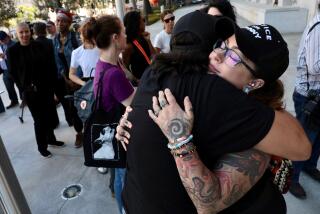Job Logs Cited by Both Sides in Kraft Trial
- Share via
A swimwear distributor testified Wednesday that Randy Steven Kraft was working for him in Torrance on the night that one of the 16 men Kraft is accused of killing was last seen alive in Carson almost 11 years ago.
For the third time since Kraft’s defense began June 30, his attorneys used work records in a bid to show that he was busy with his computer consultant business in Los Angeles County when bodies of young men were being found in Orange County.
Kraft, 43, is on trial in Superior Court in Santa Ana, accused of killing more people than any serial killer has ever been charged with slaying in California. If convicted of any of the 16 murders, prosecutors--in a bid to send him to the gas chamber--might introduce evidence at a penalty phase alleging that Kraft committed up to 45 murders.
Defense’s Picture
Defense attorney C. Thomas McDonald contends that Kraft’s work records and his demeanor among colleagues on the job were inconsistent with someone who had roamed freeways all night, picking up young men and killing them.
Prosecutors contend that the defense’s timetable of Kraft on the job helps build a case against the defendant. They said none of the employment logs show that Kraft was at work when any of the 16 victims were known to have been killed.
Swimwear distributor Donald Sheahan on Wednesday produced work records for Kraft, who was setting up computer programs for him. Here is how they relate to three of the 16 murders, according to court testimony:
- The job records show that Kraft worked at Sheahan’s Arena USA in Torrance on Nov. 16, 17 and 19, 1978. He left work at 9:30 p.m. on the 17th and returned on the 19th at 11 a.m. Kraft is charged with killing Michael Joseph Inderbeiten, 21, last seen alive at 2 a.m. on Nov. 18, 1978, walking toward a bus station near a bar in Long Beach. His body was found 4 hours later along the 7th Street on-ramp to the San Gabriel River Freeway in Seal Beach.
- The records show that Kraft was at Sheahan’s on June 18, worked past midnight and returned June 20 at 10:30 a.m. Kraft is charged with killing Richard Allen Keith, 20, last seen alive at 11 p.m. June 18 when leaving his girlfriend’s house in Carson. His body was found about 6 hours later on Moulton Parkway in Laguna Hills.
Over the defense’s objection, Deputy Dist. Atty. Bryan F. Brown has pointed out to jurors that Kraft could have gone through Carson--and picked up Keith hitchhiking--on his way home to East Long Beach after leaving Arena USA that night.
- The records show that Kraft worked at Arena on July 5, 1978, from noon to 8:30 p.m. and on July 6, 1978, from 2 p.m. to midnight. Kraft is charged with killing Keith Arthur Klingbeil, a transient from Washington state, whose body was found about 3:30 a.m. on July 6, 1978, in a northbound lane of Interstate 5 in Mission Viejo.
The records also show that Kraft worked during the week before and the week after the June 11, 1978, death of Roland Gerald Young, whose body was found in Irvine. McDonald also introduced testimony that a week before the Inderbeiten killing, Kraft was at his niece’s wedding in Costa Mesa.
“What we have here is a picture of Randy Kraft living a normal life style, doing normal things at the time all this was going on,” McDonald said after the court session.
While McDonald was pleased with Sheahan’s testimony, he lost another round with Judge Donald A. McCartin on Wednesday in his attempt to put before jurors the names of other potential suspects in the killings.
McCartin refused to let him elicit testimony in front of the jury that mass murderer William C. Bonin, convicted of 14 murders in Southern California in 1978-80, was once a suspect in any of the Kraft murders.
McDonald wanted jurors to hear testimony that fibers found on one of the victims had once been compared with known fibers in some of the Bonin cases. Prosecutor Brown contended that the testimony would be irrelevant because the lab reports showed that the fibers did not match, and the judge agreed.
After the court session, McDonald complained that “the jurors should be given a chance to evaluate any information that might be relevant.”
He said this would probably not be his last attempt to get Bonin’s name in front of the jury.
More to Read
Sign up for Essential California
The most important California stories and recommendations in your inbox every morning.
You may occasionally receive promotional content from the Los Angeles Times.













